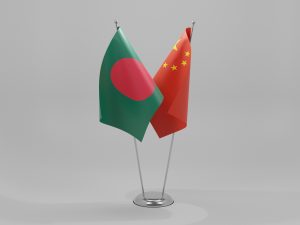Shaikh Abdur Rahman

Bangladesh, an emerging Asian economic power, has sustained strong economic growth in recent years. The country has now set itself an ambitious GDP growth target of 7.2 percent for the fiscal year 2021-22. At the 76th United Nations General Assembly (UNGA), Prime Minister Sheikh Hasina echoed the promise to revive the country’s economy in the post-COVID “new normal” and achieve developed nation status by 2041. Infrastructure and communications are the two major components to achieve this goal.
China’s Belt and Road Initiative (BRI) aims to strengthen regional cooperation by creating tantamount economic partnerships by linking the subregions of South Asia, Southeast Asia, and the Middle East. Though the Bangladesh-China-India-Myanmar Economic Corridor – one of the six corridors of the BRI – has proven dead on arrival due to India’s concerns about China, Bangladesh can still harness the opportunities for enhanced commerce and connectivity through the BRI.
However, mirroring the discussions around Pakistan’s Gwadar port and Sri Lanka’s Hambantota, the issue of a “debt trap” is also a discussion point for Bangladesh. How much of a concern is the narrative of China’s “debt trap” or “debt diplomacy” for Bangladesh?
Like other emerging economies, Bangladesh is keen on expanding its infrastructure. However, Bangladesh does not get a spontaneous flow of funding from other developmental partners – see, for example, the withdrawal of World Bank funding from the Padma Bridge. This led the country to lean toward the BRI. Bangladesh became a part of the BRI in 2016 and has seen its ties with Beijing grow exponentially in recent years, especially since Chinese President Xi Jinping visited Dhaka in October 2016. China is currently the biggest trading partner of Bangladesh and Bangladesh is set to receive Chinese investments of over $40 billion under the bilateral partnership. From 2009 to 2019, the Dhaka Tribune found that China invested an estimated $9.75 billion in transportation projects in Bangladesh.
Currently, nine projects are running under the BRI in Bangladesh, including the mega project of the Padma Bridge Rail Link, Bangabandhu tunnel under the Karnaphuli River, and Dasher Kandi Sewerage treatment plant. The success of BRI projects in Bangladesh is highly dependent on the sustainable financing and economic viability of the projects.
Sustainable financing of BRI projects is an important issue for building confidence among the participating countries. Bangladesh is the second-largest recipient of Chinese loans under BRI in South Asia after Pakistan. China invested over $60 billion as part of the China Pakistan Economic Corridor (CPEC). At the same time, it has stepped up its huge infrastructure investments in Bangladesh worth $10 billion. While Pakistan is in a difficult position with respect to its indebtedness to China, Bangladesh has been a cautious borrower.
A comparative analysis of the external debt ratio with other BRI member countries that are falling into the so-called “debt trap” suggests that Bangladesh is in a good position to manage its external debt compared to its counterparts. For instance, in the case of Sri Lanka and Pakistan, the debt ratio to nominal GDP is 104 percent and 41 percent, respectively. In the case of Bangladesh, the foreign debt stock stood at around $78.04 billion in fiscal 2020-21, which is about 22 percent of the country’s GDP. So the China debt issue is not a concern for Bangladesh, as it has already shown its prudence in effectively managing external debt.
On the other hand, the average interest rate on these loans is approximately 1.23 percent, and the country has an average of 31 years to repay the loans, with an average grace period of eight years. This fits well with Bangladesh’s current financial strength. In addition, Bangladesh avoids over-reliance on Chinese loans through balancing with Indian and Japanese financial and construction expertise. If Pakistan is seen as a classic example of a debt crisis, then Bangladesh can be seen as an example of creating a “win-win situation” with the BRI.
Moreover, Bangladesh is not as deeply linked to the BRI project, as Pakistan is, so there is nothing like an obligation for Dhaka. In an article in The Diplomat, Sudha Ramachandran noted that “None of the projects the Chinese are executing in Bangladesh have strategic implications.” Bangladesh should continue its current stance on the BRI, which focuses solely on economic terms. More importantly, Bangladesh has rejected projects that are not economically sustainable. For instance, Bangladesh called off the Chinese project at Sonadia, realizing that its close location to the Japan-proposed deep-sea port project at Matarbari made China’s proposed port redundant. Through its economic-focused approach, “Dhaka largely avoided the main pitfalls of the China initiative while at the same time adopting the gains,” Ramachandran concluded.
Last but not the least; Bangladesh is strategically important both for the United States and China as part of the Indo-Pacific Strategy and BRI, respectively. The BRI project, however, has much more economic upside for Bangladesh compared to the Indo-Pacific Strategy. The country should pursue a concrete line of economic engagement with China through the channel of the BRI, while maintaining a “balancing” relationship with the United States.
Based on current trends, there is less possibility that Bangladesh will fall into the so-called debt trap like Pakistan; rather, the BRI may pave for more avenues for accelerating the economic development of the country. Dhaka’s partial and watchful engagement with the BRI will create a win-win situation and a concrete bilateral partnership between the countries.
No comments:
Post a Comment